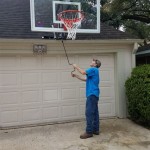Chamberlain Garage Door Wireless Keypad Not Working After Battery Replacement
A common issue encountered by homeowners with Chamberlain garage door openers involves the wireless keypad malfunctioning after a battery replacement. The keypad, designed for convenient and keyless entry, can become unresponsive, leaving individuals locked out or unable to operate the garage door remotely. This article explores the potential reasons why a Chamberlain garage door wireless keypad may not function following a battery replacement, offering troubleshooting steps and solutions to restore proper operation.
The Chamberlain brand, a significant player in the garage door opener industry, utilizes wireless technology in its keypads for ease of installation and use. These keypads typically operate on radio frequency (RF) signals to communicate with the garage door opener motor unit. They rely on batteries for their power source, and when the batteries are depleted, a replacement is necessary. However, replacing the batteries doesn't always guarantee a seamless return to functionality. Several factors can contribute to the keypad’s failure to operate correctly after the battery swap.
Understanding the mechanics of how the keypad interacts with the garage door opener is crucial in diagnosing the problem. The keypad sends a coded signal to the receiver in the garage door opener motor. This signal contains information authorizing the opener to activate. The receiver must recognize and validate the code for the door to open or close. Any disruption in this communication process, whether due to incorrect programming, interference, or hardware issues, can lead to a non-working keypad.
Incorrect Battery Installation and Battery Type
The most basic, yet often overlooked, cause for a malfunctioning keypad after a battery replacement is incorrect battery installation. It is imperative to ensure that the batteries are inserted with the correct polarity, matching the positive (+) and negative (-) markings inside the battery compartment. Even a slight reversal of one battery can prevent the keypad from powering on or transmitting signals.
Furthermore, using the correct type of battery is equally important. Chamberlain keypads typically require specific alkaline batteries, often AAA or 9V, depending on the model. Using batteries with a different voltage or chemistry can lead to inconsistent performance or complete failure. Rechargeable batteries, while seemingly convenient, may not provide the consistent voltage output required for reliable operation. It is recommended to refer to the keypad's user manual or the Chamberlain website for the specified battery type.
Even if the correct battery type is used and polarity is observed, the quality of the batteries can impact performance. Using old or low-quality batteries may not provide sufficient power for the keypad to function correctly. It's advisable to use fresh, high-quality alkaline batteries from a reputable brand to ensure optimal performance.
Another aspect to consider is the battery terminals within the keypad. Over time, these terminals can become corroded or bent, leading to poor contact with the batteries. Inspecting the terminals for any signs of corrosion and gently cleaning them with a cotton swab and a small amount of rubbing alcohol can improve the connection. Bent terminals can be carefully straightened to ensure proper contact with the batteries.
Reprogramming Issues and Synchronization Problems
Chamberlain keypads require proper programming to communicate with the garage door opener. After a battery replacement, the keypad may lose its programming, requiring it to be reprogrammed to the garage door opener's receiver. The reprogramming process involves pressing specific buttons on both the keypad and the garage door opener motor unit, followed by entering a security code on the keypad.
The exact reprogramming procedure varies depending on the specific Chamberlain model. Therefore, consulting the user manual is crucial. The manual provides step-by-step instructions tailored to the specific keypad and garage door opener. These instructions typically involve pressing the "Learn" or "Smart" button on the garage door opener motor unit. This button activates a learning mode, allowing the receiver to recognize the signal from the keypad.
During the reprogramming process, it is important to follow the instructions precisely. Errors in the process, such as pressing the wrong buttons or entering the incorrect security code, can prevent the keypad from synchronizing with the garage door opener. It may be necessary to repeat the reprogramming process multiple times to ensure successful synchronization.
In some instances, the garage door opener’s memory may be full. Most openers have a limited number of devices (keypads, remotes, etc.) that can be programmed into their memory. If the memory is full, the opener will not accept a new device until an existing one is erased. Consult the opener’s manual to determine how to clear the memory, typically involving pressing and holding the Learn button for a specified duration.
It’s also important to verify that the garage door opener is functioning correctly with other remotes or devices. If the opener itself is not responding to any signals, the issue may lie with the opener’s receiver rather than the keypad itself. This would necessitate troubleshooting the garage door opener unit directly.
Signal Interference and Range Limitations
Wireless communication relies on radio frequency signals, which can be susceptible to interference from other electronic devices operating on similar frequencies. Common sources of interference include Wi-Fi routers, cordless phones, and other garage door openers in close proximity. This interference can weaken the signal from the keypad, preventing it from reaching the garage door opener receiver.
The distance between the keypad and the garage door opener motor unit can also affect signal strength. Exceeding the keypad's specified operating range can result in a weak or non-existent signal. Obstacles such as walls, metal doors, and landscaping can further attenuate the signal, reducing the effective range.
To mitigate signal interference, consider relocating potential sources of interference, such as Wi-Fi routers or cordless phone base stations, away from the garage. Ensuring a clear line of sight between the keypad and the garage door opener can also improve signal strength. If the distance between the keypad and the opener is a concern, consider relocating the keypad closer to the garage door or using a signal booster to extend the operating range.
Another potential source of interference is the presence of metallic objects near the keypad or the garage door opener. Metal can reflect or absorb radio frequency signals, weakening the signal strength. Removing any metallic objects that may be obstructing the signal path can improve communication. Specifically, check for metal shelving or tools stored near the opener or keypad.
In rare cases, environmental factors, such as extreme weather conditions, can affect signal transmission. Heavy rain or snow can attenuate the signal, while strong electromagnetic fields can disrupt communication. While these factors are usually temporary, they can contribute to intermittent keypad malfunctions.
Furthermore, it's worth noting that some newer appliances and electronic devices are designed to deliberately emit strong signals to maintain constant communication. This "always on" feature can contribute to a more congested radio frequency environment, increasing the likelihood of interference. Identifying and addressing these devices can sometimes alleviate signal interference issues.
If all other troubleshooting steps have been exhausted, considering a replacement keypad or seeking professional assistance from a garage door repair technician may be necessary. A technician can diagnose the problem and determine if the keypad is faulty or if there are underlying issues with the garage door opener itself.
Maintaining the Chamberlain garage door wireless keypad and proactively addressing potential issues can help prevent future malfunctions. Regularly checking the battery status, cleaning the battery terminals, and ensuring proper programming can extend the lifespan of the keypad and ensure reliable operation. Keep the user manual accessible for quick reference when troubleshooting or reprogramming the keypad.
By understanding the potential causes of a malfunctioning keypad after a battery replacement and following the suggested troubleshooting steps, homeowners can often resolve the issue and restore the keypad to its proper functionality. When in doubt, consulting the user manual or seeking professional assistance can provide the necessary guidance and support.

Garage Door Keypad Not Working How To Fix Easy

Craftsman Chamberlain Remote Garage Door Opener Keypad Cold Weather Operation Failure Repair

Chamberlain Liftmaster Garage Door Opener Battery Replacement For Keypad In Panama City Fl

Changing Battery In Garage Door Opener Keypad

How To Troubleshoot Your Garage Door Keypad Spectrum Ohd

Garage Door Remote Control Not Working Program Battery Reset

How To Troubleshoot A Garage Door Keypad Raynor

How To Program A Chamberlain Wireless Keypad

9 Solutions For Garage Door Keypad Blinking And Won T Open

Chamberlain Universal Wireless Garage Door Keypad Klik2u P2 The Home Depot
Related Posts








